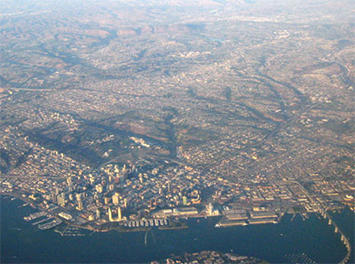
Around the world planners are seeking to increase urban densities, at least in part because of the belief that this will materially reduce automobile use and encourage people to give up their cars and switch to transit, or walk or cycle (Note 1). Yet research indicates only a marginal connection between higher densities and reduced car use. Never mind that the imperative for trying to force people out of their cars has rendered largely unnecessary by fuel economy improvements projected to radically reduce greenhouse gas emissions from cars (see Obama Fuel Economy Rules Trump Smart Growth).
Transit Use and Density: A Tenuous Connection at Best
In a widely cited study, Reid Ewing of the University of Utah, and UC Berkeley’s Robert Cervero reported only a minimal relationship between higher density and less driving per capita. In a meta-analysis of nine studies that examined the relationship between higher density and per household or per capita car travel, they found that for each 1 percent higher density, there is only 0.04 percent less vehicle travel per household (or per capita). This would mean that a 10 percent higher density should be associated with a reduction of 0.4 percent in per capita or household driving.
More people in the same area driving a little less means overall driving is greater, as Peter Gordon reminds us. This is illustrated by the Ewing-Cervero finding --- a 10 percent increase in population density is associated with 9.6 percent increase in overall driving, as is indicated in Figure 1 (the calculation is shown in the table). Ewing and Cervero placed this appropriate caution in their research: "we find population and job densities to be only weakly associated with travel behavior once these other variables are controlled."
There is another limitation to the density-transit research. The comparison of travel behaviors between areas of differing density provides no evidence that conversion of an area from lower to higher density would replicate the travel behavior of already existing (historic) areas of higher density.
Transit is about Downtown, Not Density
Ewing and Cervero also found that proximity to the central business district (downtown) is far more likely to reduce vehicle travel than higher densities. This mirrors the findings of others. The Ewing-Cervero conclusion is that, all things being equal, there is a 0.22 percent reduction in travel per capita for each one percent reduction in the distance to downtown.
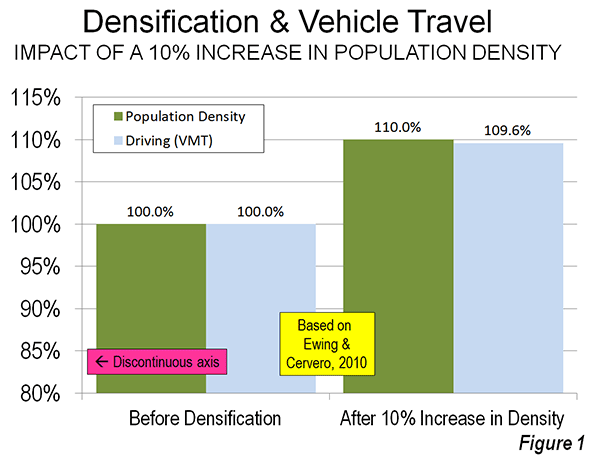
| Table | |||
| Density and Driving Example | |||
| Base Density | 1% Higher Density | 10% Higher Density | |
| Households | 100 | 101 | 110 |
| Change from Base Density | 1.0% | 10.0% | |
| Daily Driving per Household (Miles) | 10 | 9.996 | 9.960 |
| Change from Base Density | -0.04% | -0.40% | |
| Total Daily Driving (Miles) | 1,000 | 1,009.6 | 1,095.6 |
| Change from Base Density | 0.96% | 9.56% | |
| Based on Ewing & Cervero (2010) |
Transit commuting is strongly concentrated toward the largest downtown areas, which is the only place automobile-competitive mobility can be provided from large parts of the modern metropolitan area (whether in North America, Western Europe or Australasia).
This is, at least in part, why transit service provides such minimal employment access throughout major US metropolitan areas. Data from the Brookings Institution indicates that among the 51 metropolitan areas with more than 1,000,000 population, the average worker can reach only six percent of jobs in 45 minutes (see: Transit: The 4 Percent Solution). Nearly two-thirds of the jobs cannot be reached in 45 minutes, despite transit’s being nearby, while slightly less than one third of workers are not nearby transit at all (Figure 2). By comparison, the average driver reaches work in approximately 25 minutes.
Of course, not everyone can (or would want to) live near downtown. Hong Kong comes closest to this urban containment ideal, with the highest population density of any major urban area in the high income world (67,600 per square mile or 26,100 per square kilometer).Yet despite these extraordinary densities, one-way work trip travel times average 46 minutes, 20 minutes longer than in lower density, similar sized Dallas-Fort Worth.
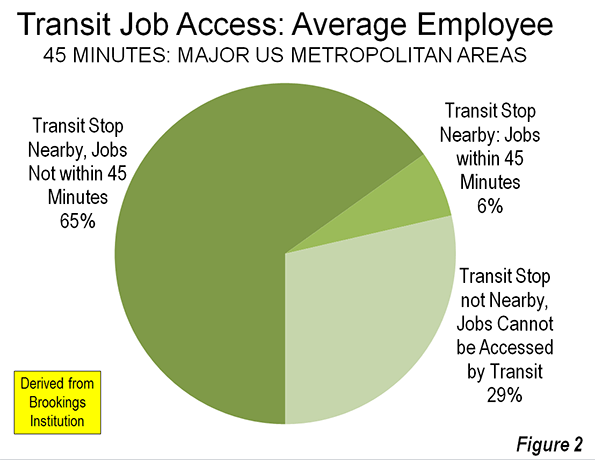
High Density Commuting in the United States
The centrality of downtown to transit ridership was a principal point of my “transit legacy city” research, which found that 55 percent of all transit commuting in the United States was to just six municipalities (not metropolitan areas). These include the municipalities of New York, Chicago, Philadelphia, San Francisco, Boston and Washington. Among the 55 percent of transit commuters in the nation who work in these six municipalities, 60 percent work in the downtown areas, which are the largest and most concentrated in the nation. This, combined with nearby high density neighborhoods, makes for transit Nirvana.
The highest population densities are concentrated in just a few metropolitan areas (Note 2). Approximately 43 percent of the nation’s population living at or above 10,000 per square mile density (approximately 4000 per square kilometer) lives in the New York metropolitan area. Despite its low density reputation, Los Angeles has the second largest concentration of densities above 10,000 per square mile, at 22 percent. Chicago's high density zip codes contain a much smaller 10 percent of the national high density population (Note 3), while nearly all of the balance is in Boston, San Francisco, Philadelphia, and Washington (Figure 3).
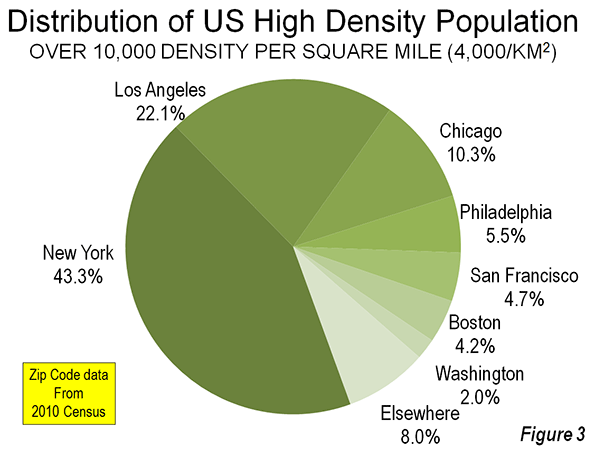
The greatest concentration of the highest densities is in New York, which has 88 percent of the national population living at more than 25,000 per square mile (approximately 10,000 per square kilometer). Los Angeles ranked second at 3.5 percent and San Francisco ranks third at 3.2 percent (Figure 4). At this very high population density, nearly 60 percent of New York resident workers use transit to get to work. No one, however, rationally believes that densities approximating anything 25,000 per square mile or above will occur, no matter how radical urban plans become.
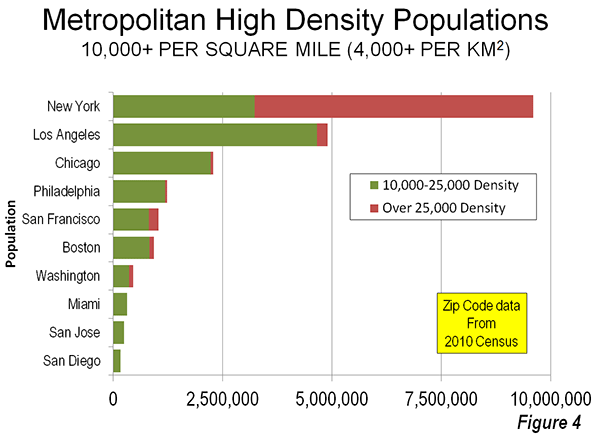
An examination of transit work trip market shares in the density range of 10,000 per square mile to 25,000 per square mile illustrates the importance of proximity to downtown. There are nine metropolitan areas in the United States that have more than 200,000 residents living in zip codes with this density. These include the metropolitan areas with the six transit legacy cities, as well as Los Angeles, Miami and San Jose. These latter three experienced from two-thirds to 90 percent of their urban growth since World War II.
San Jose’s large high density population is surprising, because it has a post-War suburban core city and, as a result, a comparatively weak downtown area. Moreover, San Jose has nearly 20 times as many people living at high densities as larger Portland, despite its more than three decades of densification policy (Note 4).
Transit market shares are by far the highest in the high density zip codes of the metropolitan areas with the six transit legacy cities, at 30 percent. This ranges from 27 percent in Chicago to 33 percent in New York and Washington. At first glance, this would be evidence of a fairly consistent transit market share for high densities among the six metropolitan areas (Note 5).
However, metropolitan areas containing the transit legacy cities are unique. Their high density areas are located near their large downtown areas (which are the largest and most concentrated employment centers in the nation), as is to be expected from urban forms that date from the 19th and early 20th centuries. The more recent urban forms of the metropolitan areas rounding out the top ten in high density residents, Los Angeles, Miami, San Jose and San Diego, are very different. Not only do they have smaller downtowns but their high density areas are not concentrated to the same degree around downtown. As a result, their high density transit work trip market shares are much lower (Figure 5).
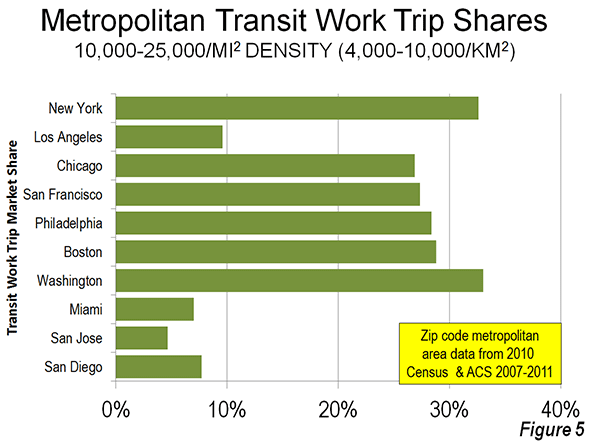
This is best illustrated by Los Angeles, the metropolitan area with the largest number of people living at 10,000 to 25,000 residents per square mile in the nation. The transit work trip market share of these high density zip code residents is 9.6 percent, one-third that of similarly high densities in the metropolitan areas with transit legacy cities.
In Miami, the transit work trip market share of high density residents is only 7.0 percent. In San Jose, the transit work trip market share for high density residents is only 4.6 percent, less than one-sixth that of the metropolitan areas with legacy cities. San Jose’s high density transit work trip market share is even below the national average for all densities (5.0 percent). San Diego’s high density transit work trip market share is 7.7 percent.
“A Negligible Impact”
The transit-density disconnect may have been best summarized by Paul Shimik in 2007 research published in the Transportation Research Record: "The effect of density is so small that even a relatively large-scale shift to urban densities would have a negligible impact on total vehicle travel."
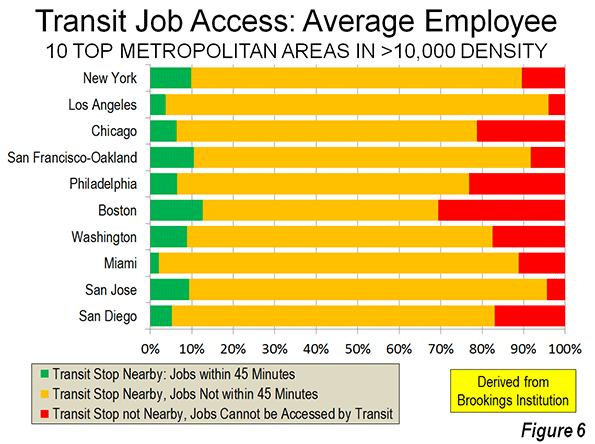
Wendell Cox is a Visiting Professor, Conservatoire National des Arts et Metiers, Paris and the author of “War on the Dream: How Anti-Sprawl Policy Threatens the Quality of Life.
-----
Note 1: This article is limited to the potential for transferring automobile demand from cars to transit. Walking and cycling have only marginal potential for reducing vehicle travel, because these modes cannot provide access throughout today’s large metropolitan (labor) markets.
Note 2: This analysis uses zip code level data from the 2010 Census and the American Community Survey for 2007-2011.
Note 3: Los Angeles also has the second highest share of its population living at densities of 10,000 per square mile and above, at 38 percent. New York has 49 percent at this density, while in Chicago and San Francisco, 24 percent of residents live at these high densities.
Note 4: Portland ranked 25th in high density (at or above 10,000 per square mile) out of the 51 metropolitan areas with more than 1,000,000 population in 2010. Portland’s high density share of its metropolitan population, at 0.7 percent, is well below that of the nation’s most market oriented development metropolitan area, Houston, at 2.0 percent and slightly below that of Dallas-Fort Worth.
Note 5: Despite their much higher transit work trip market shares in high density areas, the jobs in suburban areas in the metropolitan areas with legacy cities can be as inaccessible by transit as in the metropolitan areas with post-War core municipalities. See Figure 6.
Photo: San Diego (by author)













Transit density
Due to increase in population level especially in urban regions we have found heavy density areas. It ultimately encourages the marginal increase in automobile industries; basically due to population increase we have found the use of automobile and the rise in fuel economy. So from the above article we can get enough chance to aware about the current condition of high density regions. I hope people should understand the importance of automobile as well as environmental issues along with fuel economy.
BMW mechanic in Dallas
The Facts of This Report are Compelling
... although they fail to convince me that we must abandon "growth containment" policies and return to the free-market-free-for-all.
The numbers illustrate the difficulties of integrating the development of new urban housing with the construction of new mass-transit capacity. In an existing urban fabric, it takes decades to effect change with infill projects. Rights-of-way for surface rail are almost impossible to assemble. The most expedient solution - more buses on existing routes - is also the most heavily impacted by existing congestion.
Higher-density zoning faces opposition from neighborhood groups. Transit construction must overcome determined political opposition by powerful oil and land-development interests.
Thus far, CAFE standards have done more to decrease GhG emissions than zoning. But this is no reason to abandon smart growth policies. Neither are sufficient to solve the problem. Both offer benefits beyond GhG reduction. Inferring that more efficient cars will "fix" the problems caused by sprawl is like saying it's OK to leave your house lights on 24/7 because you've installed LED lamps.
We should not forget that sprawl has been favored by subsidies granted to fossil fuels. This includes everything from foreign wars to state laws that prohibit spending fuel taxes on mass transit.
Nor should we forget that transit commuting involves many factors beyond travel time. Some Americans commute by car simply because buses are no longer racially segregated. Other began taking the bus only after it was equipped with WiFi. In addition, there many non-transit issues - such as efficient delivery of utilities and public services - that favor growth containment policies.
People who own homes are just as indentured to their mortgage-holders as urban-dwellers are to the "rentier cless". Indeed, the single-family home's value as a discrete investment commodity is of far more value to the lender than to the homeowner. The turnover of homes generates many more fees and commissions than that of apartments. "Pro-growth" policies are not so much the result of consumer demand as they are the creature of entrenched finance, insurance and real-estate interests.
I thank the author for this very informative article. It indicates that zoning and transit policies have gotten badly out of step. It also suggests that planners should focus on building up centralized employment centers (with ancillary services) in addition to increasing housing density.
Stand on your feet, not your head
"....."Pro-growth" policies are not so much the result of consumer demand as they are the creature of entrenched finance, insurance and real-estate interests....."
This judgement is 180 degrees wrong. Wherever did you get this idea from? Did you really understand a word I said in my comment/reply to Racaille below? Perhaps you did not even read it. Please do so.
The entrenched FIRE sector is the main OBSTACLE to "pro growth" policies and the main vested interest beneficiary of growth containment policies. Gary Allen, in the 1974 article "Big Brother Wants Control of Housing", pointed out that certain property-investor Rockefellers were up to their eyeballs in funding and promoting "land conservation" advocacy.
Go back even to 1959:
http://www.rhsdplanning.com/1959
This early anti-sprawl propaganda video was funded by the National Association of Home Builders...! Of course their main players at that time were furious with the Levittown phenomenon undermining the capital gains in development for well-connected people, that was associated with the predictable "infrastructure planning" of the pre-automobile era.
The reason housing is cheap in cities without growth containment policies, is that there is little or no capital gain able to be captured by anyone. There is so much farmland within economic driving distance of the existing city, that no-one needs to pay anything higher than farmland prices for it.
How much equity is riding on the price of land per square foot in the UK's cities, which price is literally thousands of times higher than in non-growth-constrained cities in the USA? Does the FIRE sector in the UK want to see land owners everywhere and anywhere granted the right to build houses on it, thus collapsing this price of land per square foot?
THIS is the economic land rent I am talking about. I don't know how on earth you can invert the reality to claim that the "economic land rent" associated with "sprawl" is a burden to society.....! Economic land rent is minimal or non-existent under free-sprawling conditions. This is why people in affordable US cities pay one tenth as much for a quarter acre lot as British pay for one sixteenth of an acre. In fact Australians, New Zealanders, and Canadians in many cities are now almost as badly off as the British thanks to urban planning sadists, in spite of these nations superabundance of space....!
There is no way "savings" in the costs of transport or of infrastructure, can mitigate housing cost inflation of this magnitude. A house in a UK city, or Vancouver or Sydney or Auckland, that costs $700,000 - $1,500,000, is the equivalent house, even in its efficiency of location relative to employment and amenities, to one that costs $100,000 - $350,000 in an affordable US city. The difference is all in economic land rent. The efficiently located apartment in the unaffordable city is also at least $500,000, while the same thing in an affordable US city is under $100,000 - even with massive trade-off of space, economic land rent makes this much difference.
You display a good understanding of the difficulties inherent in "intensification" and transit oriented development, not the least that existing residents don't want it. So is your solution, the construction of entire new transit-oriented cities on greenfields land, or compulsory acquisition of whole swathes of existing cities and over-riding of NIMBY rights? Either would illustrate actual sincerity on the part of the smart growth advocates.
It is revealing that the planners allege existential crises facing humanity to justify urban growth containment, yet apparently the crises are not so serious after all to justify State force to actually achieve the alleged objectives. Very convenient. Just enough interference in the market to deliver massive economic rent to the FIRE sector, and no more.
The allegation that driving is "subsidised" is a non-argument anyway. No-one pays for a driver's car purchase or depreciation or insurance or fuel or repairs and maintenance. Why should the taxpayer subsidise almost all of these things for transit riders - direct subsidies in most cases being 75 to 98%? The most adventurous calculations of the "subsidies" to car driving show them to be around 5% to 10%.
By all means abolish subsidies and level the transport playing field, but this means transit charging fares that cover ITS costs too. By the way, petrol taxes in Europe are so high that not only is there no "subsidy" to driving, driving is a substantial net contributor to government revenue. Yet even though transit is heavily subsidised in Europe, most travel is STILL by car, the level of difference with the USA being only 10% or so.
Cars versus transit is like cellphones versus public telephone boxes and it is time to understand and accept reality and get out of the 19th century transportation/land rent paradigm. Or sell the public on the "existential threat" argument, sufficient for them to relinquish the concept of private property, period. Good luck with that.
Well, once again you are wrong...
The urban design of Los Angeles, San Diego, San Jose and Miami is a direct result of cheap oil and misdirected government policy i.e. pro-sprawl.
And therefore, by definition, poorly planned and totally independent of their overall density.
The Modern Inquisitors
"Pro sprawl" government policy is "misdirected"? Why? Compared to what?
Cities of the pre automobile era were undesirable places to live, and governments certainly did not do the wrong thing by promoting a spreading out of the population, democratisation of home ownership, the end of "the tyranny of rent", and far healthier living conditions.
Any remnants of pre-automobile living conditions in cities is everywhere regarded as a social crisis (hint: we call them "ghettoes"), and you are saying that government policies that addressed the universal nature of these living conditions at one time, was "misdirected"?
It is economically impossible to lift living standards and eliminate the tyranny of rent and democratise home ownership without "sprawl". The fact that growth containment advocates do not understand this, means that they are dangerous people to entrust with any influence over policy.
The fact is that there is a "land rentier" class of people, and they love the maximisation of economic land rent. They were massively disinherited by automobile based development, but growth containment reinstates their zero-sum-wealth-transfer gains. Growth containment advocates are these people's useful idiots.
You simply won't see all those nice fancy mod-cons associated with yuppies condos, in the lives of the greater number of people forced to live at higher densities by "planning" - economic land rent will swallow so much of their incomes there won't be anything left to pay for niceties. Look at the conditions in UK cities. There is a national crisis with homes that are old, dilapidated, drafty, leaky, tiny, lacking insulation, lacking basic repair, suffering from high local pollution levels, and lacking local amenities. The cost of land rent swallows so much of people's incomes (this is how "monopoly rent" works) that there is nothing left in the local economy for basic repairs and maintenance, let alone renewal.
And birth rates among responsible people have collapsed due to the cost (and lack of quality) of housing, while the feckless breed freely and the cost to the beleagured taxpayer, of "social" housing for the feckless, becomes another increasing crisis.
The UK's growth-constrained urban economies are 20% to 40% less productive because of their growth constraints, unnaturally high density, and inflated land costs. The disadvantage has been calculated by Cheshire and Sheppard (2002) to be some 5% per year - which effect is of course compounding over time. Until the UK's policy makers wake up to this, the UK economy is condemned to permanent decline.
The study referenced by Wendell Cox makes perfect sense. Traffic congestion is increased by higher density and the losses in efficiency from this always more than negate the "gains" from allegedly shorter travel distances. However, the "pricing out" effect that results from inflated land costs, actually increases travel distances as well. Ironically, people spend LESS time traveling to work in a very low density city like Indianapolis, than they do in a very high density city like Manchester UK. And Indianapolis has housing several times the size on average, for half the cost on average - and it's a whole lot newer and higher quality.
If there is basis to discourage the use of fossil fuels and reduce carbon emissions, these things should be "priced" appropriately by way of taxes, and participants in the free market should be free to make the most efficient responses that apply in their circumstances. Some people will choose large-lot living, will have a well-insulated home, will use active and passive solar energy, a geothermal heat pump, collect rainwater, grow their own food, burn biomass for heating and cooking, use fresh air and breezes to ventilate their home and dry washing, use recycling and composting - all things that are ruled out for high density accommodation. And this "sustainable" affordable home will very likely be located far more efficiently to the jobs of the household's income earners and to schools and other amenities, than the detestable "options" available to the rent-gouged masses in a planned high density city.
People who can afford it, will own and drive a modern and efficient car - many of which are available NOW, that have a greater efficiency than the average mass transit system.
The growth containment theocracy are really a modern equivalent of the Inquisitors, for their pre-enlightenment ignorance, absolutism, sadism, and service of an oppressive power structure.